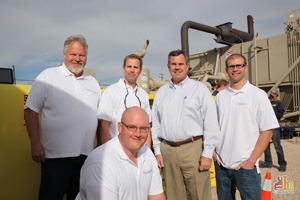St. George engineering company poised to go global, double operations
Written by Josh Warburton, Publisher
A St. George engineering company called Helidyne has big plans to go global, plans that should materialize in January when their first client, Pemex, Mexico’s state-owned petroleum company, is set to take possession of their first pair of Helidyne’s unique, locally-built energy conversion units. A showcasing of the technology, two central pieces of which Helidyne has patents on, was held on a small piece of St. George city property located on Sunland Drive on Thursday and Friday. Mayor Jon Pike and representatives of Questar gas, as well as the seven-member staff of Helidyne, were on hand Friday to display the actual units which have already been painted in Pemex’s requested yellow and lime green colors and are set to ship in January to a platform in the southern Gulf of Mexico.
So what does Helydine do? According to the literature distributed at the event, “Helidyne’s positive displacement expander is designed to capture waste energy in the oil & gas industry. Unlike inefficient letdown/JT valves, the Planetary Rotor Expander (PRE) uses available pressure drops to generate useful mechanical/electrical power.”
In layman’s terms, it turns mostly wasted heat and pressure into usable energy.
 According to Helidyne’s website, the company was founded in 2008 with a focus on geothermal energy generation. Co-founder and CEO Kevin Kerlin is optimistic that the pair of units currently set in an open area of St. George city property normally used for electrical transformer storage will pass the necessary testing and be sent to the harsh real-world conditions of an oil platform at sea.
According to Helidyne’s website, the company was founded in 2008 with a focus on geothermal energy generation. Co-founder and CEO Kevin Kerlin is optimistic that the pair of units currently set in an open area of St. George city property normally used for electrical transformer storage will pass the necessary testing and be sent to the harsh real-world conditions of an oil platform at sea.
The successful shipping will also mark a huge financial step, as Pemex plans to place an order for eight more pairs to be installed in 2015, necessitating major expansion for Helidyne.
“We’ll be looking at moving out of our 6,000 square foot facility and getting into maybe a 15,000-20,000 square foot facility to house it all, so we’re just anxious to get that new order,” Kerlin said. “We’ll likely have to double our staff at that time. We desperately need a control engineer…We’ll need a shop manager, a product procurement manager, a lot of techs, and one or two mechanical engineers.”
If all goes as planned, Helidyne hopes to ship Pemex a large order of 290 more units for 145 offshore oil platforms in 2016. Mayor Pike considers making the space available to Helidyne, who also agreed to give any power generated back to the city of St. George, a part of economic development.
“It’s a win-win. We want to see this kind of thing happen,” said Pike about the install which started in September. “I’m very impressed that by just providing them a little bit of space, they could set this up, demo it to show it to potential customers, and do all the testing required. They’re going to be doing huge things…I’m excited to have them here in St. George.”
Questar Gas representatives were on hand both as the gas supplier for the large compressor used for the testing of Helidyne’s PRE units and also as a potential customer. Kerlin stated there were three current Questar sites where these units could be installed in the St. George area alone.
“We can install these at their regulator stations where the gas comes in at about 800-1100 psi and they drop it down to 400 psi. Well, right now that pressure drop is a complete waste, so we can install an expander and harness 50-60 Kilowatts off that, which they could sell off or even use themselves. It might take a while for that to happen. When you’re competing with on-shore electric prices, the payback is going to be not as attractive, but offshore and remote locations are where you could get a fairly quick payback of one to two years, which is our target.”
Kerlin said they plan to put the next generation of the units to the test starting in January with a 1000 consecutive-hour test that may take until March or longer to complete. The large compressor unit used as part of the testing has been leased for one year but will likely be there longer as plans for continuous testing take place.
“First we’ll do the 1000 hours of internal testing,” Kerlin said. “That’s a benchmark, then go on.”
That’s the name of the game: buyers want a safe and reliable product.
Click on the right to get our Sunday Edition via email –>




